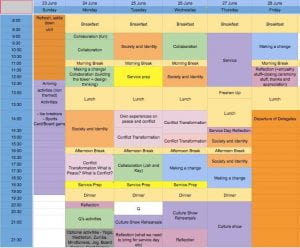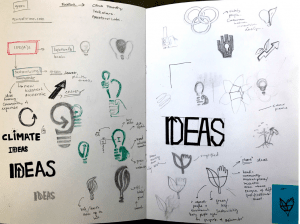Highlight of the trip: Last session I planned of conflict transformation – intense impact
What I learnt about being a good facilitator:
- The importance of guiding, not teaching: I had to focus on speaking less and allowing delegates to independently learn and make the connections on their own time.
- The greatest understanding of peacebuilding is developed through the delegates internal linking and absorption of the strategies and topics we discussed.
- The level of involvement and enthusiasm of both the facilitators and delegates fluctuates, which is perfectly normal.
- The determinant of the success of the conference is the change and progress delegates make in their own communities in the time following the conference. The effects of peacebuilding are often not immediately seen.
One thing i learnt about running a conference :
- You have to be very flexible. The service day planning particularly struck me as an important learning curve since we were faced with the challenge of organizing the plans for the day on the spot. Although it was chaotic at first, it taught me how greatly I value the having a team that is quick thinking and hands on.
- Speaking and giving instructions – pace and voice, power of pausing.
- Use examples and templates – people need guidance (having visuals for people to look at will help them anchor what you’re saying to something tangible)
- In the case of IFP, a very valuable (but often overlooked) piece of advice I would give is to treat them like they’re people and not a service project. Listen with intent, and respond with care, just as you would in any other friendship.
Big takeaways +- from each day
Monday/Tuesday – In the sessions over monday and tuesday we handled subjects of identity and stereotypes and began introducing ideas of design thinking. A few times during the first few days I would question if the activities we ran were relevant or even necessary since we spent so much time doing fun interactive activities that aimed to help one learn more about themselves, the stereotypes they hold and their identity: what they value most, who they really are. Then I realised that although I have done so much self evaluation and reflection over my years in school, many of these individuals attending the conference hadn’t. A lot of them were not ever given this voice or opportunity to explore themselves and deeply reflect. So although the first few days went a bit slow, it was necessary in building the general comfort level of the group, and allowing individuals to get into the mindset of evaluating what makes them them. It set up a great foundation for the very vulnerable and emotional sessions that preceded.
Wednesday – #LO6 The trauma of the conflicts and violence these people have experienced and still experience doesn’t end when this conference ends. Moe Tee still has to return to an unstable family setting, and Tint Tint still cannot go home in fear of the civil violence. The last session my group ran was an emotional session that for many of them provided a sense of catharsis. Each individual wrote anonymously on two cards: a moment of pure peace and happiness and an experience with conflict/violence. The cards were then placed randomly around the room, and we sat and read the cards for 45 mins. This activity was so emotional as it provided them with a window of pure vulnerability if they chose to. Many cards were deeply impactful and after the session, the tears and the shock brought people closer together, and made people feel empowered and supported. I was very proud of myself and my group for running such a session. It took awhile for me to realise that although the session went well and I felt like celebrating, the issues that many of them had spoken or written about were still impacting their lives, and might continue the moment they leave the conference. The fact that many delegates had skipped days of school and saved up money to make it to the conference, evoked a sense of guilt within me the moment I remembered I was off to a relaxing summer abroad the moment the conference ended.
When I was attending IFP as an afterschool activity, I hadn’t yet grasped the magnitude of impact it would have on me or others; it was simply an afterschool activity. I’m grateful to the movement and people that encompass what IFP, for pushing me to develop a passion for peacebuilding.
Thursday – #LO5 Being on the service team and having to coordinate the service morning was both extremely stressful yet rewarding. It proved itself a big obstacle as it was hard to prepare the service morning in our sessions at school because of the limited amount of information we could access. Because the delegates would have to plan their own service session and what they wanted to do, we couldn’t inform Kritsana (our contact at the hotel) and our partnered school what kind of activities they were going to do. When it came time to explain the service morning to the delegates it was very unclear and left most people confused and quite worried as for many of them, it was their first time planning their own volunteer/service session. After the horrid explanation session, the service team sat for an hour and a half and worked through our prominent issues.The next day we visited the school and cleared up many questions such as what the space looks like, how many children each group would work with etc. Another surprise was that we were also forced to change the day the service session ran (wednesday to thursday). Working in the service team showed me how flexible one must be when organising and planning events or conferences. On the day itself, though I did a lot of running around and making sure everything was running smoothly, it was the thorough preparation and planning that the team did last minute that made it a successful morning. The importance of planning but also anticipating change and adapting to it was an incredibly vital lesson I learnt through planning the service morning.
#LO7 making a change last session – delegates were incredibly ambitious, but more than that were logical and structured plans on how to change their communities. Whether it was creating weekend workshops to educate the youth on drug use, running days for tree planting programmes or creating educational apps for iphone and androids – each of these delegates had a logical and structured plan on how to begin. It was incredible seeing the template and knowledge that the “Making a Change” Group had presented, been applied to each of their plans. It wasn’t just a dream anymore, but was becoming a tangible plan, and that was the most important thing to see. The service hours and the sessions we ran ultimately had no meaning of these individuals didn’t take anything away from it. It’s great everyone made new friends, but the conference wouldn’t have been successful if no change was made after it ended. The real results of success arise not now, but later: when we see the impact these delegates had on their community. Peacebuilding is never instantaneously effective, often the impacts only reveal after a while, and only then can we determine the success of conference we facilitators created.
Friday – Goodbye ceremony. Farewell session. 🙁


IMG-2096IMG-2004
‘



